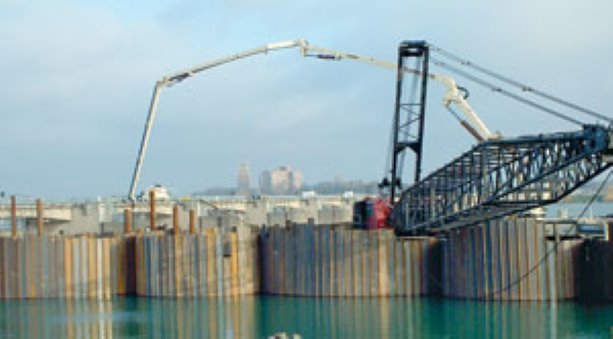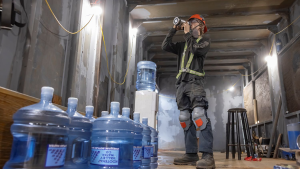A gigantic steel sheet cofferdam made up of seven interlocking islands constructed on the Niagara River half a kilometre above Niagara Falls is raising eyebrows in the engineering community.
Innovation
Unique challenges working in rapids above Niagara Falls
A gigantic steel sheet cofferdam made up of seven interlocking islands constructed on the Niagara River half a kilometre above Niagara Falls is raising eyebrows in the engineering community.
At 200 by 450 feet, it is one of the largest cofferdams in the world. It was built as the egress point for a huge tunnel boring machine (TBM) building the 10.4-kilometre Niagara Tunnel project. The TBM has a diameter of 47 feet – about 2.5 times the size of the TBM used construction of the Toronto subway tunnel and 1.5 times the size of the ones at the English Channel tunnels.
When completed Ontario Power Generation’s $985-million tunnel will carry water from the river entering at the cofferdam to the Sir Adam Beck Power Station which will generate enough hydroelectricity for 160,000 homes.
Bermingham Foundation Solutions was contracted to design and build the cofferdam. Doug Nemec, project manager of the Hamilton-based contractor, says the cofferdam has been a complicated and risky job.
“Designing and building a giant cofferdam for the largest rock TBM in the world and installing it in one of the most powerful rivers in North America can be daunting.
“It was a tribute to the entire team, that a project of this complexity and size was completed in the short construction window that the Niagara River allows,” adds Nemec.
Peter Smith, vice-president of the Bermingham, says the most important factor during construction was to anticipate what could go wrong and plan ahead for it. “If we made a serious mistake, we risked the cofferdam filling with water.”
In most cofferdam projects, steel sheets are driven deep into the riverbed where the soil acts as a seal, but because the Niagara riverbed above the diversion dam is bedrock, Bermingham had to come up with a different solution. It designed a series of seven 55-foot diameter enclosures made up of interlocking steel sheets (plates on watertight bases) formed around a template that essentially looks like “a Ferris wheel laying on its side”.
Most of the steel sheets are 25 feet tall; some are 40 feet tall, used where a slot was cut into bedrock for a new water acceleration wall to ensure enough water entered the tunnel at force to run the generators at Sir Adam Beck. The steel plates are 5/8-inches thick.
Giant templates, which follow the riverbed’s contours, were made to build a steel frame to hold the interlocking steel sheets tightly in place.
"It was a tribute to the entire team that a project of this complexity and size was completed in the short construction window that the Niagara River allows."
Doug Nemec
Bermingham Foundation Solutions
To keep water out, divers installed sand bags at the inside base of the structures and a 400-millimetre concrete layer was pumped through a tremie pipe around the outside base and held down by 15 feet of gravel, says Smith.
The final watertight measure taken was to drill 200-foot deep holes at the riverbed around the inside of the enclosures and “pressure inject” them with grout, says Smith. “Basically, they created a curtain of grout underneath the cofferdam so the water can’t get in.” Geo-Foundations was the subcontractor retained for the grout work.
They then filled each of the seven enclosures with gravel and removed the templates. The enclosures were filled with gravel and compacted to form islands for workers and equipment, including a 250-tonne mobile crane.
A bridge was constructed of rock rubble from shore to the first enclosure. An interlocking concrete caisson wall, typical of shoring done for highrises on downtown Toronto’s waterfront, built on the land side of the cofferdam ensures watertightness.
The last enclosure, unlike its circular neighbors, was rectangular and made to the width of the bridge piers. The enclosure was keyed into the slot in the pier normally used for stop logs, Smith explains.
To help divert more water from the tunnel, a precast concrete acceleration wall was built from a barge by McNally Construction Inc. The contractor also blasted the slot in the riverbed about 70 feet wide by 20 feet deep.
“We had to come up with a way of engineering the cofferdam through this area so it would be watertight.”
To accomplish that, 40-foot-long steel sheets were dropped to the base of the cut-away slot and a diver marked the shape of the bottom on the sheets so they could be brought to the surface, cut with torches and then re-installed.
Bermingham superintendent Brent Porteous says McNally worked closely with Bermingham to schedule work so both contractors could work in the water together.
Another challenge which added to the potential danger of the work was the river’s fast-moving current, up to 20 knots – 25 miles per hour – in some places. Builders chose to work just upstream of a diversion dam to an old power station where the pace of the current could be controlled, says Smith.
While the water above the diversion dam was calm, the operation was still risky for workers, who were required to wear lifelines and lifejackets at all times.
“If you were to throw a stick into the water at the dam, four minutes later it would be at the bottom of the falls,” Smith says.
Originally, Bermingham was given two years to plan and detail the project, but because Strabag AG Inc. faced a late penalty clause of $250,000 a day, it tightened the schedule, allowing Bermingham only 14 months for the work.
Smith says the cofferdam is probably the largest built in Canada since the St. Lawrence Seaway locks were constructed in the 1950s.

Once the massive cofferdams were constructed, the tunnel boring machine had a clear pathway to bore through the Niagara River bed.











Recent Comments
comments for this post are closed